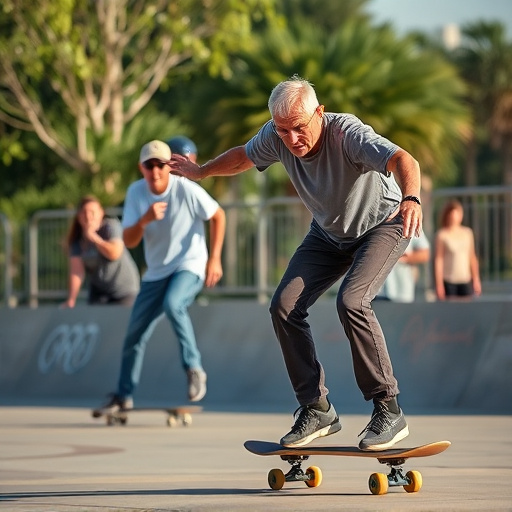Skateboarding is accessible and beneficial for individuals aged 40 and above, with tailored fitness approaches addressing age-related changes. Dynamic stretching before skating and static stretching afterward improve flexibility, reduce injury risk, and enhance performance. Targeted exercises focusing on key muscle groups ensure optimal mobility, balance, and skill retention. Incorporating deep tissue mobility techniques like myofascial release and foam rolling further benefits older skateboarders, preserving their active lifestyle. This approach allows them to continue enjoying skateboarding while mitigating age-related physical challenges.
Skateboarding is not just for teenagers; it’s a lifelong passion for many. As skateboarders age, understanding their unique needs becomes crucial for maintaining flexibility and performance. This article explores stretching routines tailored for aging skateboarders over 40. From recognizing the benefits of regular stretching to addressing common challenges, we provide insights on creating a dynamic warm-up routine, incorporating static stretches, and advanced techniques for deep tissue mobility, all designed to keep you cruising smoothly on the half-pipe or street.
- Understanding the Unique Needs of Skateboarders Over 40
- The Benefits of Regular Stretching for Aging Athletes
- Common Flexibility Challenges Faced by Mature Skateboarders
- Creating a Tailored Stretching Routine for Seniors
- Incorporating Dynamic Warm-ups Before Skate Sessions
- Static Stretches: When and How to Perform Them
- Advanced Techniques for Deep Tissue Mobility
Understanding the Unique Needs of Skateboarders Over 40

Skateboarding is often associated with youth, but many enthusiasts continue to ride well into their forties and beyond. As skateboarders age, their bodies go through natural changes that require a nuanced approach to fitness routines, especially when it comes to stretching. Understanding the unique needs of skateboarding over 40 is crucial for maintaining flexibility, reducing injury risk, and ensuring a continued love for this active lifestyle.
Compared to their younger counterparts, older skateboarders often face increased stiffness in joints, reduced muscle mass, and slower recovery times due to age-related declines in mobility and strength. These factors demand a more targeted stretching routine that focuses on improving range of motion in key areas such as hips, shoulders, and ankles—all vital for skateboarding maneuvers. Incorporating dynamic stretches before riding and static stretches post-ride can significantly benefit skateboarders over 40, helping them stay agile, balanced, and injury-free on the deck.
The Benefits of Regular Stretching for Aging Athletes

For aging skateboarders, regular stretching routines offer a multitude of benefits that go beyond mere flexibility. As athletes age, their joints and muscles become stiffer, which can lead to reduced performance and increased risk of injury. Incorporating dynamic stretches before riding and static stretches afterward can help maintain mobility, improve balance, and enhance overall skateboarding skill.
For skateboarding over 40, specific stretching exercises should target key areas like hamstrings, quadriceps, hips, shoulders, and back. These tailored routines not only prepare the body for the physical demands of skateboarding but also promote better posture and a lower risk of common age-related injuries. By prioritizing flexibility through consistent stretching, older skateboarders can continue to enjoy their passion while showcasing smooth moves on the deck.
Common Flexibility Challenges Faced by Mature Skateboarders

Creating a Tailored Stretching Routine for Seniors

Incorporating Dynamic Warm-ups Before Skate Sessions

Before every skateboarding session, aging riders should focus on dynamic warm-ups to prepare their bodies for the physical demands ahead. Unlike static stretching, which is held in one place, dynamic stretches involve active movement that mimics skateboarding maneuvers. This method increases blood flow to muscles, improves range of motion, and enhances overall flexibility—all crucial factors for skateboarders over 40 looking to maintain agility and reduce injury risk.
Start with gentle movements like arm circles and leg swings to get the blood pumping. Follow this with more specific warm-ups such as high knees, butt kicks, and lateral shuffles. Incorporating these dynamic stretches into your routine will not only help prevent injuries but also enhance performance during your time on the board.
Static Stretches: When and How to Perform Them

Advanced Techniques for Deep Tissue Mobility

For aging skateboarders looking to maintain their active lifestyle, advanced techniques for deep tissue mobility are essential. Beyond traditional stretching, incorporating myofascial release and foam rolling can significantly enhance flexibility and range of motion. These methods target the deeper layers of muscle and fascia, which often become tight and restricted as we age, especially after years of intense skateboarding.
Skateboarders over 40 should focus on self-myofascial release techniques like using a foam roller to apply pressure along muscle groups, encouraging the body’s natural healing response. Additionally, exploring yoga practices tailored for older adults can introduce dynamic stretches and balanced poses that improve overall mobility and balance, crucial for maintaining skateboarding skills as one ages.
For aging skateboarders, maintaining flexibility and mobility is key to continuing their passion for the sport. By understanding the unique needs of those over 40, incorporating dynamic warm-ups, and tailoring stretching routines with a mix of static and advanced techniques, skateboarders can enhance their performance and reduce injury risk. Regular stretching helps improve range of motion, supports joint health, and keeps the body prepared for the demands of skateboarding. Adopting these practices allows seniors to enjoy the sport they love, navigating the skatepark with confidence and grace.
